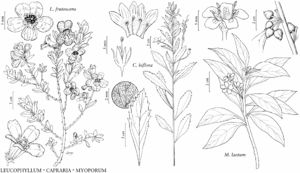Myoporum
Fl. Ins. Austr., 44. 1786.
| Taxon | Illustrator ⠉ | |
|---|---|---|
 | Leucophyllum frutescens Capraria biflora Myoporum laetum | Linny Heagy Linny Heagy Barbara Alongi |
Shrubs or trees; stolons absent. Stems ascending to prostrate, glabrous. Leaves persistent, cauline, alternate, rarely opposite, with embedded, translucent glands; stipules absent; petiole present [absent]; blade fleshy or not, leathery or not, margins entire or serrate. Inflorescences axillary, in clusters [flowers solitary]; bracts absent. Pedicels present; bracteoles absent. Flowers bisexual; sepals 5, calyx radially or bilaterally symmetric, campanulate, lobes oblong; petals 5, corolla white [pale-purple], spotted with purple [orangebrown to yellow or unspotted], radially or bilaterally symmetric, campanulate, abaxial lobes 3, adaxial 2, lobes glabrous [pubescent] abaxially, variously pubescent adaxially; stamens 4–8, adnate to corolla, equal, filaments hairy [glabrous], staminode 0; ovary [2–] 4 [–6] -locular, placentation apical; stigma capitate or 2–5-lobed. Fruits drupelike capsules, ovoid to globular, fleshy [dry]. Seeds 1–4, white to pale-brown, ovoid to oblong or ellipsoid, wings absent. x = 18.
Distribution
Introduced; Calif., Indian Ocean Islands, Pacific Islands, Australia, also in s South America
Discussion
Species ca. 30 (3 in the flora).
Myoporum species have been introduced for ground cover or hedges in coastal or low rainfall regions of many countries, especially M. insulare R. Brown, M. laetum, and M. montanum R. Brown. The gall-inducing thrip Klambothrips myopori, native to Australia, has recently been introduced to California and is causing substantial damage to Myoporum species used in landscaping (L. A. Mound and D. C. Morris 2007). The leaves and fruits of M. laetum and other Myoporum species are toxic to livestock; they contain ngaione, a furanoid sesquiterpene that causes photosensitization and liver damage (G. S. Richmond and E. L. Ghisalberti 1995; K. Parton and A. N. Bruere 2002).
Selected References
None.
Lower Taxa
Key
| 1 | Shrubs, prostrate; leaf blades narrowly oblanceolate, 2–4 cm; capsules white to pale brown. | Myoporum parvifolium |
| 1 | Shrubs or trees, broadly spreading; leaf blades narrowly elliptic to lanceolate, 5–14 cm; capsules pale to dark reddish purple. | > 2 |
| 2 | Leaf blades lanceolate, margins finely serrate distal to middle, glands conspicuous; flowers 2–4 per axil; anthers well exserted from tube; ovaries smooth. | Myoporum laetum |
| 2 | Leaf blades narrowly elliptic, tapering proximally and distally, margins entire, glands inconspicuous; flowers 6–8 per axil; anthers slightly exserted from tube; ovaries rugose. | Myoporum acuminatum |